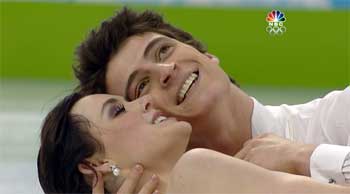 Here are three reasons I loved last night’s gold medal ice dancing winners, Tessa Virtue and Scott Moir: They had spectacular chemistry on ice, they were the first North Americans to win the gold medal (in their first Olympics!), and…they weren’t siblings.
Here are three reasons I loved last night’s gold medal ice dancing winners, Tessa Virtue and Scott Moir: They had spectacular chemistry on ice, they were the first North Americans to win the gold medal (in their first Olympics!), and…they weren’t siblings.
Even the silver medal winners, Meryl Davis and Charlie White, and bronze medal winners, Oksana Domnina and Maksim Shabalin, had a believable connection while performing…and none of them were siblings.
At this year’s Olympics, four sibling ice dancing pairs were competing, and whenever a sibling pair took the ice, I couldn’t help but cringe with slight embarrassment when they had to skate close to each other (what I call “body skimming”), grab onto each other longingly, and pretend to near-kiss each other’s lips and faces.
I know that sometimes the best partners may be the ones who know you the best and who can anticipate your every move. Also, I know that for the sake of competing and winning, a sibling is no longer a sibling but an objective character, actor, and performer. However, ice dancing is, in many ways, all about intimacy and being in tune with another person’s body and movements. Plus, if you’ve ever seen ballroom dancing (or watched “Dancing with the Stars“), you know how steamy certain dances can become…and when you think about a sexy tango or a sexy rhumba (on or off the ice) danced by siblings, the thought is a little creepy and off-putting. Just imagine Derek and Julianne Hough performing a rhumba together…
The Wall Street Journal has a fascinating article that addresses how siblings handle the “ick factor” and awkwardness of performing racy routines on the ice. Some siblings avoid full eye contact, others find creative ways to make a routine more platonic and sibling-safe, and others…well, they just try to picture someone else’s head on their sibling’s. But still…can any sibling really forget that they’re (as one friend put it) “commiting incest on ice”?
There’s something about siblings generating (or pretending to generate) chemistry on the ice that seems less authentic than non-siblings generating chemistry; it’s easier to suspend belief and think of the latter’s performance as being more real than the former’s performance. This is not to say that siblings can’t win ice dancing competitions; in fact, French siblings Isabelle and Paul Duchesnay won silver medals in the 1992 Winter Olympics.
Still, I’m not entirely convinced that Scottish siblings Sinead and John Kerr could have achieved the personal level of intimacy that Canadians Tessa Virtue and Scott Moir seemed to share on the ice; there was just an extra, undefinable spark emanating from Virtue and Moir’s dancing. And, at the end of the day, that extra spark and connection helped them win the gold medal.
What do you think about siblings dancing on ice? Are you okay with it or do you find it just as creepy as I do?

